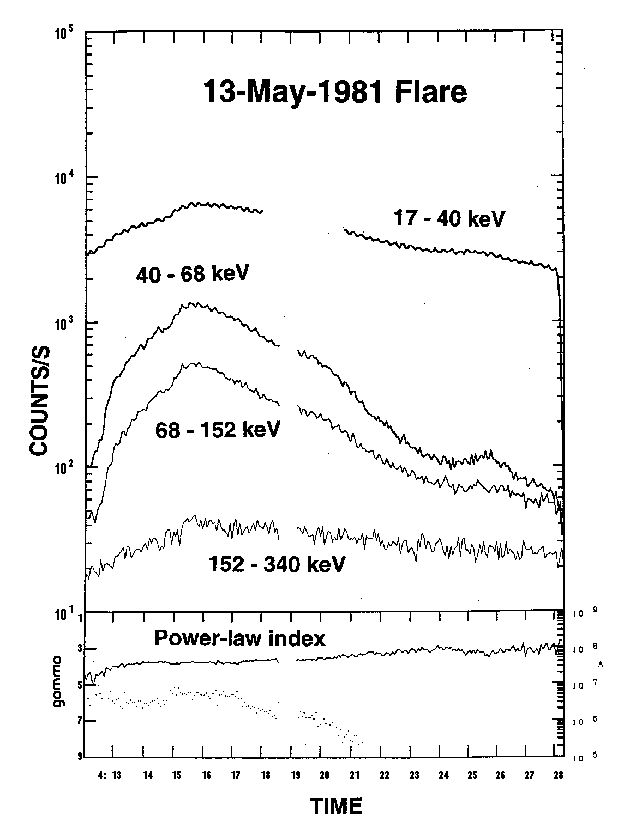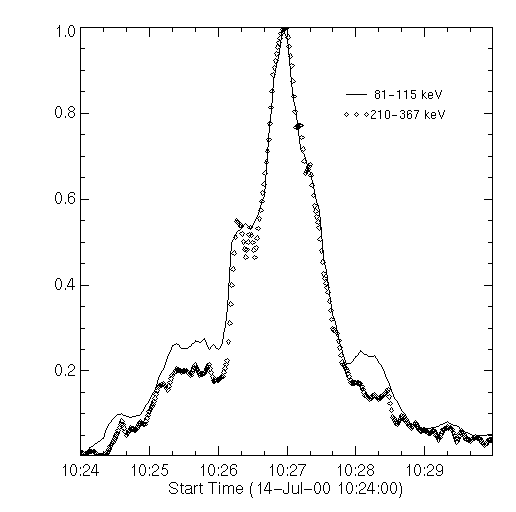
We love big flares because they are often spectacular. Whenever an X-class flare occurs, we are pleased. But some cynical people may ask "So what? The X-class simply means that the peak X-ray (1-8 Å) flux as measured by a GOES satellite exceeds 10-4 W/m2. What's special about it as compared with the peak flux of, say, 10-5 W/m2?" Indeed, largely because of the growing recognition that major geomagnetic effects including big proton events are due to coronal mass ejections (CMEs) rather than to flares, not many people seem to speak about flares lately. However, big flares are likely to be observed by many instruments covering a wide wavelength range, and thorough analysis of these data still has the potential to give us an important insight into the energy release mechanism(s). Moreover, it appears to some (including myself) that big flares tend to be associated with major (or fast) CMEs accompanying shocks which may be the primary source of space weather disturbances.
One of the main reasons for selecting this topic for a nugget is that we have already had nearly four dozens of X-class flares since the last solar minimum. If you have SolarSoft installed on your machine and get the basic database updated periodically, a one-line command "pr_gev" will readily produce a list like this ascii file . The list is extracted from the event summary we get from NOAA on a daily basis, but it is not perfect. The file from NOAA may not be comprehensive at the time of file transfer or the transfer may have problem. For example, we notice that one event at 22 UT on 18 August 1998 is missing. The archive stored at NOAA now includes it. Are there more events missing in this list?
I have also been curious about whether Yohkoh has observed so-called gradual hard flares. These flares, as observed by Hinotori, were characterized by the presence of a component with a gradual variation in hard X-rays, a spectrum above 40-50 keV (power-law index of <4) which becomes even harder after the peak as opposed to the usual soft-hard-soft pattern (see a previous nugget). A typical example is dusted off and shown below (click to enlarge).

The flare is also only known to have consisted of a coronal hard X-ray source as reported by Tsuneta et al. (1984). The hard spectrum and the coronal source (in contrast to the footpoint sources) have made researchers consider that particle acceleration in this type of event is due to shocks, which accelerate protons more efficiently, and that the hardening is due to collisional loss (lower energy particles decay faster) in a large coronal trap. Interestingly, it was associated with a major CME (according to Solwind) and a solar energetic particle (SEP) event even though the region was in the eastern hemisphere (according to NOAA.) There were about half a dozen of similar events observed by Hinotori, and all of them were X-class flares.
In summary, out of the 43 X-class flares since July 1996, a total of 23 have been observed by Yohkoh. Here "observed" means that at least the rising phase was observed. These flare are listed in the following table. Events already taken up in the SXT Science Nuggets are marked with links (A to M). If you are interested in images and movies, please look at those previous nuggets. In the table, tst and ten are start and end times, as defined by the times at which the GOES flux reached 5 % of the peak on the rise and decay. It is true that a flare can last longer at lower levels, but if I lower the threshold, it becomes harder to define these times due to background from other brightenings. The duration between tst and ten is distributed between 0.2 and 3.8 hours. Although there is no solid definition of the so-called long decay events (LDEs), which are known to be well correlated with CMEs, the rule of thumb is that flares with duration >2 hours in my scheme may be real LDEs.
As mentioned in the SXT Nuggets more than once, the flare eruptivity in soft X-rays is correlated with LASCO CMEs. Therefore, the 18 August 1998 events, with spectacular eruptions, would have been associated with CMEs if LASCO had been operational. For the 30 September 2000 event, there was a motion in SXT images, but it did not move for large distance, hence "confined eruption", which should be, contrary to some simple-minded theorists' inclinations for "unified" models, distinguished from motions that result in ejections to interplanetary space.
So far my interest has been in lower energy phenomena than during the SMM/Hinotori period, mainly because SXT data are so interesting and HXT covers only up to 90 keV. But it is of interest to see to how high energies the X-ray spectra of these X-class flares extend, in order to see if some of them may be gradual hard events. So I have looked at WBS/HXS data for the first time. Although the calibration of the HXS energy ranges is generally unknown, at least two of my colleagues (Gerry Share and Jean-Pierre Raulin) told me that the nominal energy ranges may be quite good. There are only 5 events that seem to extend to the MeV ranges. The last column shows the detection of interplanetary protons at 10 MeV or so within 1 hour after the flare. Not all the events from the western hemisphere are associated with SEP events, and not all the events from the eastern hemisphere are proton-free. There may be other important parameters, e.g., the CME speed.| Date | tst | ten |  t (hr) t (hr)
|
class | location | region | LASCO appearance | SXR eruption |
(h )high (keV) )high (keV) |
protons |
| 6-NOV-97 [A] | 11:52:51 | 12:21:33 | 0.48 | X9.4 | S18W63 | 8100 | width=135 deg | Y | >670 | Y |
| 27-NOV-97 [B] | 13:13:36 | 13:24:57 | 0.19 | X2.6 | N13E63 | 8113 | width=84 deg | Y | 394 | N |
| 23-APR-98 | 05:39:06 | 09:24:21 | 3.75 | X1.2 | S21E106 | 8210 | Halo | Y | 143 | ? |
| 2-MAY-98 [C] [D] | 13:37:36 | 14:31:57 | 0.91 | X1.1 | S15W15 | 8210 | Halo | ? | 191 | Y |
| 6-MAY-98 [E] | 07:44:00 | 09:32:18 | 1.81 | X2.7 | S11W65 | 8210 | width=185 deg | Y | 341 | Y |
| 18-AUG-98 | 08:18:54 | 08:41:54 | 0.38 | X2.8 | N34E90 | 8307 | N/A | Y | 174 | N |
| 18-AUG-98 | 22:14:18 | 23:40:51 | 1.43 | X4.9 | N30E86 | 8307 | N/A | Y | >670 | N |
| 28-NOV-98 | 05:38:57 | 07:49:00 | 2.17 | X3.3 | N17E32 | 8395 | Partial Halo | Y | 191 | N |
| 28-AUG-99 | 17:55:21 | 19:58:54 | 2.06 | X1.1 | S26W14 | 8674 | Partial Halo | Y | 143 | N |
| 27-NOV-99 | 12:09:09 | 13:30:12 | 1.35 | X1.4 | S15W68 | 8771 | Narrow Loop | N | 128 | N |
| 5-FEB-00 [F] | 19:22:09 | 19:55:03 | 0.55 | X1.2 | N26E52 | 8858 | Bright Loop Front | Y | 293 | N |
| 2-MAR-00 [G] | 08:24:15 | 08:46:30 | 0.37 | X1.1 | S14W52 | 8882 | Bright Loop | Y | 394 | Y |
| 12-JUL-00 | 10:25:24 | 11:27:45 | 1.04 | X1.9 | N17E27 | 9077 | Loops | Y | 229 | N |
| 14-JUL-00 [H] [I] [J] | 10:11:27 | 11:47:45 | 1.61 | X5.7 | N22W07 | 9077 | Halo | Y | >670 | Y |
| 30-SEP-00 [K] | 23:17:09 | 00:18:45 | 1.03 | X1.2 | N07W91 | 9169 | No CME | N | 451 | N |
| 24-NOV-00 [L] [J] | 15:04:06 | 15:44:51 | 0.68 | X2.3 | N22W07 | 9236 | Halo | Y | >670 | Y |
| 24-NOV-00 [L] | 21:52:30 | 22:52:15 | 1.00 | X1.8 | N21W14 | 9236 | Halo | Y | 174 | N |
| 25-NOV-00 [L] | 18:37:57 | 19:24:21 | 0.77 | X1.9 | N20W23 | 9236 | Halo | Y | 317 | N |
| 26-NOV-00 [L] | 16:39:30 | 17:32:33 | 0.88 | X4.0 | N18W38 | 9236 | Halo | Y | 317 | ? |
| 6-APR-01 | 19:14:36 | 20:06:42 | 0.87 | X5.6 | S20E34 | 9415 | Halo | Y | 451 | N |
| 12-APR-01 [M] | 10:16:21 | 11:45:21 | 1.48 | X2.0 | S21W47 | 9415 | Halo | Y | 229 | Y |
| 15-APR-01 | 13:45:24 | 14:32:06 | 0.77 | X14. | S20W85 | 9415 | Halo | Y | >670 | Y |
| 23-JUN-01 | 04:06:36 | 04:32:12 | 0.43 | X1.2 | N10E23 | 9511 | No CME | N | 158 | N |
Because I do not really know the performance of HXS, I cannot present a hard X-ray spectrum from the instrument. But I can probably estimate the background level from each channel and compare the background-subtracted time profiles at different energies. Here is an example from the Bastille Day 2000 flare. This plot, normalized to the peak of each energy band, shows that the decay time is similar at the two energies, i.e., no progressive hardening. Although I have not completed a systematic study, it appears that none of the X-class flares observed by Yohkoh show a soft-hard-harder pattern. Does the occurrence of gradual hard flares depend on solar cycle?

As a big surprise on studying recent X-class flares, most of them appear to be non LDEs and yet they were associated with extended or halo CMEs. We all know that many non-LDE flares are not associated with CMEs and often feel that flares in general, even when they occur close in time with CMEs, are just red herrings for the understanding of the CME initiation. But the close association of extended CMEs with non-LDE flares suggests that there is still some possibility that flares may play important roles in the acceleration of some, not all, CMEs.
Failure to find gradual hard flares while several of our flares are associated with interplanetary protons may mean the connection between the two phenomena is not strong. The X-ray emission high in the corona depends on the ambient density, which may vary from case to case. It is possible that there are shock-accelerated electrons (and protons) trapped in the high corona or moving with the CME-driven shock, but that we have to wait for a much more sensitive hard X-ray imager to observe them. In the meantime, observations in the metric and dekametric wavelengths continue to provide complementary information about shock-accelerated electrons.